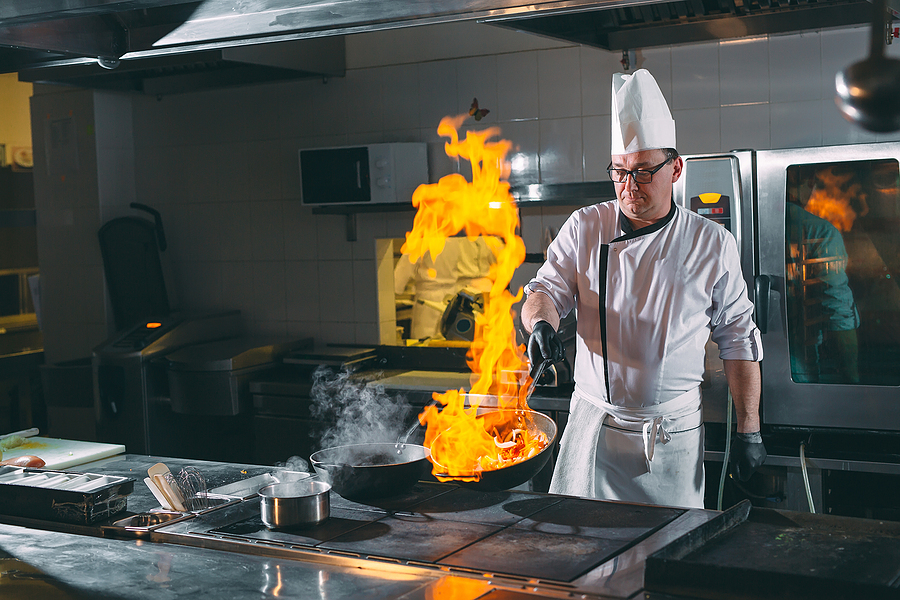Running a successful restaurant requires more than a great menu and friendly service — it also means protecting your team, customers, and property from one of the most serious threats in any commercial kitchen: fire.
From open flames to hot oil and high-powered appliances, the risk of fire in a restaurant kitchen is real — and preventable. Here’s how to proactively fireproof your kitchen and create a safer, more productive work environment.
Install a Commercial Fire Suppression System
The cornerstone of kitchen fire safety is a commercial-grade fire suppression system. Grease fires are the most common fire type in restaurant kitchens, and water-based sprinklers won’t cut it.
A suppression system connects directly to your kitchen hood and gas line. If a fire is detected, it automatically shuts off the gas and discharges a chemical suppressant through nozzles in the hood to quickly contain the flames. It’s your first line of defense — and may be required by code.
Train Staff in Fire Safety Procedures
Even the best systems require human backup. Every kitchen employee should know how to:
- Operate a fire extinguisher and fire blanket
- Manually trigger the suppression system
- Administer basic first aid and CPR
- Recognize early signs of a fire emergency
Consider scheduling a fire safety training day with your local fire department. A well-trained team can prevent minor flare-ups from becoming full-blown emergencies.
Conduct Regular Fire Drills and Safety Walkthroughs
Fire drills aren’t just for schools — your restaurant should run them too. Practice evacuation procedures, review the location of fire exits and extinguishers, and walk through the steps for containing a fire. The goal is to create muscle memory in a high-stress situation.
Make fire safety part of your regular operations checklist and keep exit routes clearly marked and unobstructed.
Maintain Proper Ventilation Systems
A poorly ventilated kitchen doesn’t just make for an uncomfortable work environment — it also increases fire risk. Heat, smoke, and grease-laden air can ignite without proper exhaust systems in place.
Be sure to:
- Install a commercial-grade range hood
- Clean hood filters and ducts regularly
- Ensure ventilation systems meet local code requirements
Dirty hoods and blocked vents are major fire hazards. Don’t let preventable buildup become a catastrophe.
Wear Proper Attire and Footwear
Fire safety begins with the right uniform. Staff should wear:
- Closed-toe, non-slip shoes to protect against spills, scalds, and falling objects
- Flame-resistant or snug-fitting garments (no loose sleeves near open flames)
A proper dress code can reduce the chance of injury — and help staff respond quickly in an emergency.
Use Non-Slip Mats and Signage
Slips and falls during a fire evacuation can be disastrous. Keep high-traffic areas safe with non-slip mats and clear signage. Wet floors and greasy surfaces can easily lead to injury — or slow down a critical exit.
Always place “Caution – Wet Floor” signs after mopping, and repair damaged flooring as soon as possible.
Guard Equipment and Monitor Use
Restaurant kitchens rely on powerful machinery — mixers, slicers, fryers — that, when misused, can spark fires or cause injury. Equip appliances with proper safety guards, and ensure staff only operate equipment they’re trained to use.
Keep flammable items away from cooking stations and turn off unused appliances during downtime.
Establish Cleaning Protocols
Grease buildup is fire’s best friend. Establish daily, weekly, and monthly cleaning schedules to:
- Degrease appliances and hood vents
- Safely store and dispose of oil
- Sanitize all surfaces and prep areas
Train staff on safe chemical handling to avoid creating toxic or flammable combinations during cleanup.
Require Occupational Health & Safety Training
Beyond fire safety, your team should be trained in general occupational health and safety best practices. A safety seminar can cover:
- Emergency response procedures
- Safe food handling and hygiene
- Electrical and chemical safety
- Proper lifting and injury prevention
The more your team knows, the safer your kitchen becomes.
Make Fire Safety a Culture — Not a Checklist
Fire safety is not a one-time fix; it’s a daily discipline. Reinforce a culture of safety by:
- Posting fire safety reminders in staff areas
- Holding monthly safety meetings
- Encouraging staff to report hazards promptly
An empowered team is your best defense against kitchen fires.
Final Thoughts
Keeping your restaurant kitchen fire safe isn’t just about checking off a to-do list — it’s about protecting your team, your customers, and your business. By taking these critical steps, you’ll reduce risk, increase safety, and create a workplace where everyone feels confident and secure.
Fire safety starts with preparation. Start implementing these strategies today — your kitchen, staff, and bottom line will thank you.
